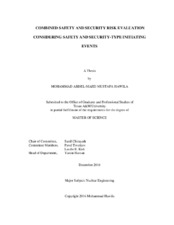| dc.description.abstract | Destruction to critical nuclear infrastructures would have a debilitating effect on national public health safety, national economy, security, etc. For this reason, analysts perform safety risk analyses to quantify and understand the nature of unwanted events. Since the world has gone through many changes after the terrorist attacks of 9/11, nuclear security risk analysis became a necessity. So far, the safety and security risk analyses were done separately without a combined analyses and evaluation. This research thesis contains three major analysis sections that provides security, safety, and combined safety-security risk analysis that studied and analyzed possible accident scenarios.
This research starts with the security pathway analysis, which eventually calculated the initiating event frequency of a successful adversary attack and estimated the security risk value. The safety analysis represented a series of natural (random) safety systems failure events. On the other hand, the safety-security analysis considered a security initiating event followed by safety systems failure. Fault and event trees were formed using the SAPHIRE software and used for the description of failure scenarios.
The main outcome of this research is a methodology development to perform combined safety-security initiating event analysis to compute the joint top event system failure frequency. Along with the calculation of the systems’ failure frequency, estimation of the public risk associated for sample failure scenarios, and the determination of how security initiating events in a series of safety events failure affect the total risk value was also carried out. Considering a security attack as an initiating event that triggers safety system failure was analyzed for developing the methodology to perform a combined safety-security risk analysis estimation.
The analysis showed that the security attack substantially changed the risk value when it was considered in the failure process. This created a major need to consider both the security and safety failures together in the future systems for failure scenarios. More evaluations should be done to the security system measures to reduce the total associated risk value. Future efforts should look for further enhancements and development in the analysis of the deployed safety and security systems. | en |


